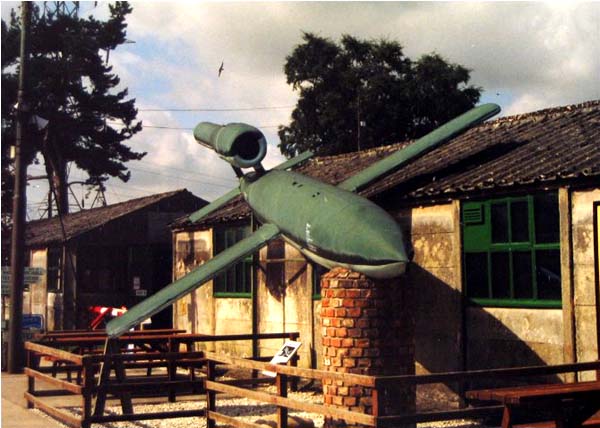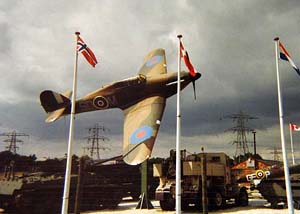Revisiting "Britain's Finest Hour" at Eden Camp
by Nick Walton
From the early days of the Second World War, a steady stream of
Axis Prisoners of War arrived in Britain. At first the numbers
were small. Since officers were segregated from lower ranks, the
first German officers were held at Grizedale Manor in Lancashire.
So expensive and luxurious were these accommodations that one
Colonel Wedgewood asked in the House of Commons, "Would it not be
cheaper to hold them at the Ritz Hotel in London?"

After the first allied victories in North Africa, such luxury
was no longer practical and new camps were needed to hold the
flood of enemy prisoners By the end of the war over 600 POW
camps had been constructed around Britain. One of the few to
survive is Camp 83, also known as Eden Camp, near Malton in North
Yorkshire. Situated in the rolling countryside between York and
Scarborough, Eden Camp exists today as an award-winning modern
history museum telling the story of World War Two through the
eyes of POWs and civilians on the home front.
Built in 1942 by Italian POWs, Eden Camp originally consisted of
45 brick and wood "huts." Eighteen huts housed 64 prisoners
each. The other huts served as workshops, kitchens, mess halls,
recreation halls, and even a hospital. Standing guard over the
entrance to Eden Camp is a vehicle park with tanks, artillery,
and other wartime vehicles as well as replicas of the two
aircraft that have become synonymous with the war for many
Britons: the Hurricane and the Spitfire.
Inside the gate, 32 surviving huts house the museum. Each hut is
a separate exhibit, with an emphasis on the wartime experience
using a combination of lifelike moving figures, realistic sounds,
and even smells of wartime. Logically enough, the museum begins
at Hut One. Here the story of Hitler's rise to power is told.
Visitors can listen in as a British family gathers around the
wireless to hear Chamberlain's September 3rd, 1939 broadcast
announcing the state of war between Britain and Germany.
Hut Three covers the U-Boat war in the Atlantic. Many of Eden
Camp's prisoners were captured submariners and this exhibit
allows visitors relive the experience aboard a German U-Boat
during a depth charge attack. Like several other exhibits, this
one can be a little intense and claustrophobic.
Moving on through the camp you will see how Britain prepared for
war and the expected German invasion. Hitler' s Blitzkrieg
attacks on London are depicted in vivid detail in Hut Five. In
this particularly moving exhibit the nighttime bombings are
simulated, complete with Civil Defense Wardens screaming orders
and the smell of smoke drifting from the crumbling remains of a
home that took a direct hit.
Hut Seven shows "The Street at War." Even though the severe
restrictions of wartime meant that shop windows were sometimes
bare and strict rationing was in place, the people of Britain
found ways to "make do." The display of a family's weekly food
ration may make you wonder how you would survive in their shoes.
The life of the prisoners is examined in Hut Ten. With over 60
to each hut, the accommodations were a long way from the luxury
of Grizedale Manor, but prisoners were comfortable and generally
well treated. In Britain enemy POWs received the same rations as
British soldiers. This meant that for most of the war POWs
received a larger food ration than British civilians.
 The Geneva Convention prevents officers from working,
but enlisted prisoners could and did perform work, both inside
and outside the camp. At one point there were 169,000 Axis
prisoners working in agricultural positions in Britain and a
further 22,000 employed in construction. They received a wage
for their labor and several times during the war protests and
even strikes were staged by British workers concerned about their
jobs going to POWs. The Geneva Convention prevents officers from working,
but enlisted prisoners could and did perform work, both inside
and outside the camp. At one point there were 169,000 Axis
prisoners working in agricultural positions in Britain and a
further 22,000 employed in construction. They received a wage
for their labor and several times during the war protests and
even strikes were staged by British workers concerned about their
jobs going to POWs.
Prisoners had a great deal of free time, so classes and
activities were available. Eden Camp, like many others, had drama
societies and orchestras performing regularly, often in nearby
villages. Part of the exhibit in Hut Ten shows arts and crafts
produced by Eden Camp prisoners. The level of artistry and
craftsmanship in some of the work is truly remarkable.
True buffs of this period of British history may want to linger
in Hut 18. Here in the War News Reading Room a copy of the front
page of a newspaper for virtually every day of the war is
available for browsing.
Throughout the camp there are outdoor displays of vehicles and
other wartime hardware. Visitors can touch a V-1 flying bomb,
face down a 25-pounder howitzer, or crawl inside a back-garden
air raid shelter.
Huts 24 to 29 make up a museum-within-a-museum covering the
battles and campaigns of the war. These exhibits are well
executed and worth a look, but the attraction of Eden Camp is in
the war at home in Yorkshire rather than the jungles of Borneo or
the beaches of Normandy. An expansion of the museum for the
Millennium also saw the opening of huts dedicated to World War
One and Britain' s post-1945 conflicts. The World War One hut is
particularly effective at portraying the trenches of France.
After making your way through the camp and seeing the stories of
women at war, wartime shopping, and the Blitz, you'll find a
slice of the home front after World War Two: a "prefab." These
simple prefabricated homes were cheap and easy to build in the
postwar years when Britain's economy and infrastructure struggled
to recover. Outside the prefab is a Garden of Remembrance
dedicated to a mother and daughter who lost their lives during an
air raid on July 13th 1943.
World War Two was the defining event of the 20th century for
Britain. The Britain of today was shaped by the events of
1939-1945. Eden Camp is almost unique among the country' s many
war museums in showing what life was like for those enemy
soldiers who went from the battlefields of Europe and Africa to
the hayfields of Britain. For many who felt no allegiance to
Hitler' s Reich, their internment was almost welcome after years
of bitter combat. Some prisoners remained in Britain after the
war, especially those who found that their former homes were now
behind the Iron Curtain.
Eden Camp also personalizes the war by devoting so much space to
the ordeal of ordinary Britons: the housewife trying to feed her
family on meager rations, the grandfather digging for victory,
the Home Guard ready to defend the island with pitchforks and axe
handles, and the children trying to be children at a time when
the world around them was thrown into chaos. It is a museum that
shows that even in Britain' s darkest days the people still
laughed and went on with life as best they could. This, every
bit as much as the Spitfires of Churchill's RAF, made the Second
World War Britain's Finest Hour.
Getting There
Eden Camp is located off the A64 between York and Scarborough,
near the intersection with the A169. The museum is open from
10am until 5pm, seven days a week (check ahead around Christmas),
but the last admission time is 4pm. At least three hours are
recommended to see the museum. In addition to the exhibits there
is a "Prisoner's Canteen" cafeteria, an "Officer's Mess Tearoom"
and the "Garrison Cinema Bar" which serves Eden Camp Beer. For
more details telephone Eden Camp at (01653) 697777, or visit the
website at http://www.edencamp.co.uk
More Information:
We regret that we no longer have the resources to maintain up-to-date links and/or hours and pricing details for the various sites and attractions listed on this website. For more information about the location(s) listed above, please use your favorite search engine or visit Wikipedia.
Nick Walton is a native of northern
England, but has lived in the US for over twenty years. He is a
professional pilot who has been published in several aviation
magazines. He enjoys frequent visits to Britain with his wife
Donna, and hopes to do more travel writing in the future.
Article and photos © 2006 Nick Walton
| 